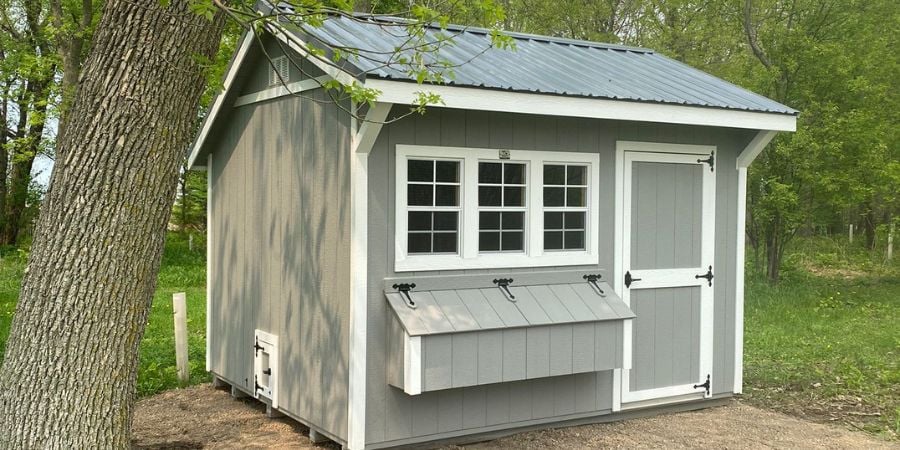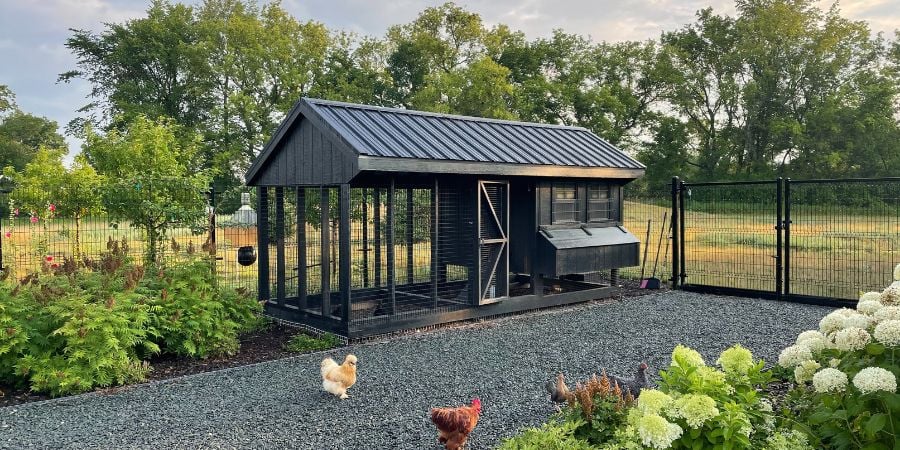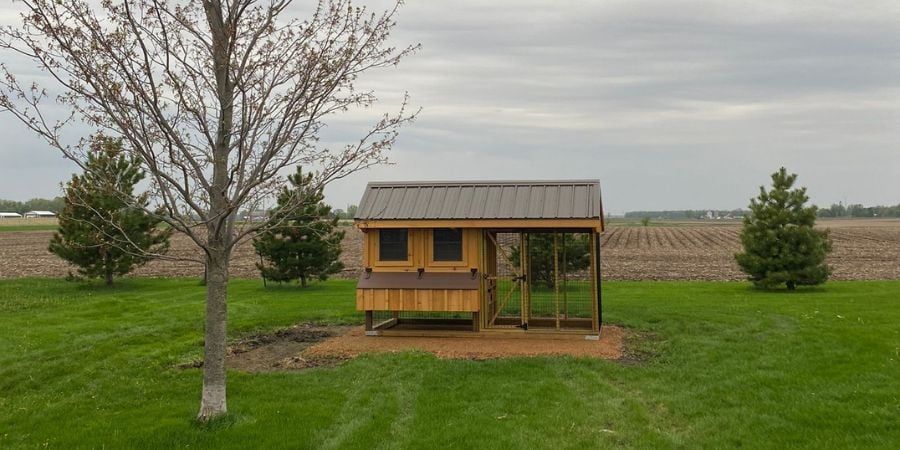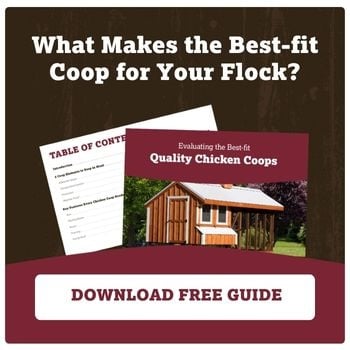What is a Chicken Coop? Safe, Comfortable Homes for Chickens
by Dakota Storage Buildings, on May 06, 2024

You may ask yourself, what is a chicken coop, or why would I need one? In the vibrant world of backyard farming, the chicken coop serves as the very foundation of a flourishing poultry environment. Its role is essential for the well-being and safety of the flock. Despite this, a surprising number of enthusiasts find themselves uncertain about the complexities of a free range chicken coop design. This widespread uncertainty often results in coops that fall short of the necessary standards, compromising the chickens' well-being and their ability to thrive and produce. By addressing the often overlooked details that contribute to a chicken's quality of life — from the security of predator-proof latches to the comfort of well-placed insulation — we move towards more informed, compassionate poultry care. Let’s examine the details that make up a high-quality chicken coop, ensuring they are not only safe and functional but truly facilitate a thriving, vibrant flock.
Key Factors in Choosing the Perfect Coop

The chicken coop is the foundation of your flock's safety, health, and overall well-being. But with so many options and factors to consider, how do you choose the right coop for your flock? By thoughtfully considering these key factors, you can select a chicken coop that meets the specific needs of your flock.
Understanding Your Coop's Purpose
A chicken coop serves multiple essential functions that are vital for the well-being and productivity of a backyard flock. Coops are a secure shelter against predators and harsh weather and provide a comfortable space for egg-laying. A clean and spacious coop minimizes the risk of disease and parasites, making it essential for maintaining a healthy, stress-free, and productive flock.
Assessing Your Flock's Needs
Every flock has its unique needs that can impact the coop, from size, breed, behavior, and health considerations. These needs should directly influence the design and features of your chicken coop. For instance, certain breeds may require more ventilation or insulation to thrive, while others might need more space to roam and engage in natural behaviors.
Determining Flock Size
The size of your flock is a critical factor in selecting a coop. Overcrowding can lead to stress, health issues, and reduced productivity among your chickens. Ensure your chosen coop provides ample space for each bird to live comfortably, considering both current and future flock sizes. As a general guideline, allow for 2-4 square feet per chicken inside the coop, with an additional 8-10 square feet in an outdoor run for enclosed coops.
Additional Considerations
There are several other considerations that can influence your choice of chicken coop:
Aesthetics: The appearance of your chicken coop should complement your backyard and personal style. Aesthetically pleasing coops not only enhance your property but also make poultry farming a more enjoyable experience.
Placement: The location of your coop in your yard can affect your flock's exposure to sunlight, wind, and predators. Choose a spot that provides adequate sunlight for warmth and egg production, protection from harsh weather, and is easily accessible for cleaning and egg collection.
Type of Coop: Before you invest in a coop, you will need to choose between an enclosed and free range chicken coop. An enclosed coop and run keep the flock safe and secure at all times. These may be more suitable in areas with high predator risks or extreme weather conditions. A free range chicken coop gives chickens the freedom to roam freely during the day and return to the safety of the coop at night. Both types have their advantages and can be tailored to suit the needs of your flock.
Must-have Features in Your Chicken Coop
Chickens are susceptible to a variety of threats that can compromise their safety and well-being, requiring a level of protection that only a thoughtfully designed free range chicken coop can provide. It is important to know what is needed in a chicken coop. A high-quality coop design includes several critical features aimed at safeguarding the flock from predators, ensuring their health, and promoting a stress-free environment conducive to rest and productivity.
Latching Lid: A latching lid is a crucial feature for chicken coops, as it helps to stave off airborne predators that may pose a threat to your flock, especially during the night when chickens are roosting and vulnerable.
Vents and Ventilation: Vents are essential components of a chicken coop, facilitating proper airflow and ventilation to maintain a healthy environment for the birds. They help regulate temperature and humidity levels, preventing the buildup of moisture and ammonia that could lead to respiratory issues. Ventilation openings should be strategically placed to promote airflow without creating drafts that could chill the birds.
Doors: Doors play a pivotal role in the security of a chicken coop, and it is crucial to ensure they have proper locks and latches. Small cracks or holes in doors can provide entry points for predators or pests, posing risks to the safety of your flock.
Lighting: Adequate lighting is vital for a hen's health and egg-laying productivity. Chickens require around 14-16 hours of light per day to maintain their egg-laying cycle, especially during the darker winter months. Installing lighting fixtures in the coop can help mimic natural daylight and ensure consistent egg production.
Roosting Bars: Roosting bars provide chickens with elevated perches to sleep on during the night. These bars should be positioned at varying heights to accommodate the natural pecking order of the flock and prevent overcrowding, ensuring a comfortable resting space for each bird.
Nesting Boxes: Nesting boxes are essential for providing hens with secluded spaces to lay their eggs. These boxes should be placed in quiet, dark corners of the coop to mimic natural nesting behavior and encourage egg-laying. Adequate bedding material should be provided to cushion and protect the eggs.

Flooring and Bedding: The flooring and bedding material in a free range chicken coop should provide a comfortable and sanitary environment for the birds. Materials like straw, wood shavings, or sand can be used as bedding, offering insulation, cushioning, and absorbency.
Access Points: Access points, including doors and hatches, should be strategically located to allow easy entry for cleaning, feeding, and egg collection. These access points should be equipped with secure locks and latches to prevent unauthorized entry by predators or pests.
Space Considerations: When designing a chicken coop, it's essential to consider the space requirements for the flock. Providing adequate space per bird helps prevent overcrowding, aggression, and stress, ensuring the overall health and well-being of the chickens.
Top 5 Tips for Happy, Healthy Chicken

The comfort of your chickens is equally important for their overall well-being and productivity. Providing a haven where your flock can thrive involves several key practices.
1. Keep Chickens Hydrated
Preventing water from freezing is a vital concern. Chickens need constant access to fresh water, and in freezing temperatures, ensuring water availability becomes a challenge. Utilizing water heaters or insulated water containers can prevent water from freezing, guaranteeing that your chickens stay hydrated, healthy, and happy even during the coldest months.
2. Insulate the Coop
Proper insulation is paramount for maintaining a stable and comfortable internal temperature. This is especially critical in areas where temperatures can fluctuate dramatically, ensuring that the cold of winter and the heat of summer do not adversely affect your chickens.
3. Choose Bedding for Warmth
Using insulated bedding, such as straw or wood shavings, adds another layer of warmth and comfort to the coop interior. This type of bedding not only keeps the chickens warm by trapping heat but also contributes to a dry environment by absorbing moisture, reducing the risk of disease and discomfort among the flock.
4. Optimize Roosting Space
Providing ample space for each chicken to roost comfortably is essential. Roosting bars should be placed at a suitable height and spaced appropriately to prevent overcrowding and to allow for the natural pecking order to establish itself without causing stress or injury.
5. Promote Health With Dust Baths
Creating areas for dust baths within or near the coop is also beneficial for chicken comfort and health. Dust baths are a natural behavior that helps chickens maintain their feather health and control parasites. Providing a designated area filled with sand or fine dirt enables chickens to engage in this essential grooming behavior, enhancing their well-being and quality of life.
The Benefits of Various Coop Types for a Thriving Flock
From traditional fixed designs to portable structures, the world of free range chicken coops offers numerous options to suit various preferences and climates. Whether opting for a DIY project or investing in a pre-made coop, understanding the different types ensures the perfect fit for our flock's needs.
Traditional Coops

Traditional fixed coop designs are durable, stable, and stress-free solutions. These coops typically feature a permanent structure with sturdy walls and a solid roof, providing long-term shelter for chickens in all weather conditions. Traditional coops come in various sizes and configurations, ranging from small backyard models to larger structures suitable for commercial poultry farming operations. Ultimately, there is an option for every space and budget. While these coops may require more initial investment and construction time, they offer the advantage of customizable features and long-term reliability.
Portable or Mobile Coops
Portable or mobile coops offer flexibility and versatility, making them a suitable option for backyard enthusiasts and small-scale poultry keepers. These coops are designed to be lightweight and easy to move. This gives you the ability to rotate the coop to maximize grazing areas and control your yard’s health. Portable coops often feature wheels or handles for convenient relocation, making them an excellent choice for those with limited space or those seeking to integrate chickens into existing gardening or landscaping plans.
Do-it-yourself Coops
DIY enthusiasts may opt to build their coop from scratch, allowing for complete customization. DIY coops can be tailored to suit specific flock sizes, housing requirements, and aesthetic preferences, providing a truly personalized housing solution for chickens. However, without the right experience and materials, these coops can take an extremely long time to build and may end up being subpar.
Elevate Your Flock's Well-being With the Ideal Chicken Coop
Choosing the right chicken coop is a pivotal decision that requires careful consideration for any backyard farmer. It is more than just providing shelter; it is about establishing a sanctuary where your flock can flourish. A well-designed coop is essential for ensuring the safety, comfort, and overall health of your flock. It should offer ample space for roosting, nesting, and free movement, allowing your chickens to exhibit their natural behaviors. The right coop plays a crucial role in maximizing the benefits your chickens offer, such as a steady supply of fresh eggs and natural pest control. Investing time and effort into selecting the perfect coop is essential for both the well-being of your chickens and the success of your backyard farming endeavors.
To help you find the perfect fit for your new flock, we have put together a free guide on how to evaluate a free range chicken coop and enclosed chicken coop and run. This comprehensive resource covers everything you need to know, from assessing the size and layout of the coop to checking for essential features like ventilation, nesting boxes, and roosting bars. Whether you are considering a DIY build or investing in a pre-made coop, our guide will walk you through the process, ensuring you make an informed decision that meets the needs of both you and your chickens. Download your free copy today and give your flock the home they deserve.

























